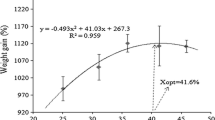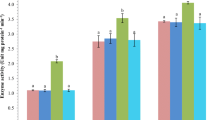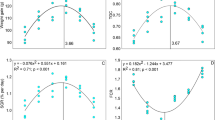Abstract
The aim of this study was to evaluate the effects of a practical diet containing different carbohydrate levels on growth rate, feed utilization, and thyroid hormones (T3 and T4) of Caspian kutum fingerlings. Fish with an initial average weight of 0.8 ± 0.2 g were fed five formulated isonitrogenous and isoenergetic diets with different carbohydrate levels of 15, 20, 25, 30 and 35 % in triplicate groups for 10 weeks. Based on the results, growth performance of Rutilus frissi was significantly affected by the dietary carbohydrate levels (P < 0.05). Maximum weight gain, specific growth rate, and protein efficiency ratio was observed in the fish fed diet with 35 % carbohydrate. Results of thyroid hormones showed that T4 levels were not significantly different by different carbohydrate levels (P > 0.05). The highest amount of T4 was observed in kutum juveniles fed with a carbohydrate level of 15 %. The levels of T4 were significantly affected by dietary carbohydrate levels (P < 0.05) with the highest amount in kutum juveniles fed 15 % of carbohydrate. In conclusion, this study indicates that increasing carbohydrate levels from 15 to 35 %, with no negative effects on growth parameters in R. frissi juveniles, leads to an efficient protein ratio and optimal growth. Moreover, no clear correlation was found between fish growth and thyroid hormones.
Similar content being viewed by others
Avoid common mistakes on your manuscript.
Introduction
Carbohydrate in the diet is an important non-protein energy source for fish and should be included in the diets at appropriate levels in order to maximize the use of dietary protein for growth. The amount of non-protein energy sources that can be incorporated in fish diets is not fully understood. No requirement for dietary carbohydrate has been demonstrated in fish; certain fish species exhibit reduced growth rates when fed carbohydrate-free diets (Moreira et al. 2008). Diets used in fish farming contain highly variable amounts of carbohydrates depending on the cultivated species. Scientific literature indicates that fish species differ in their ability to utilize carbohydrate, and that the tolerance of fish to non-protein energy is relativity low depending largely on the fish species (Webester and Lim 2002). Herbivorous and omnivorous fish are more capable of utilizing carbohydrate sources.
A variety of hormone axes have been implicated in the control of growth in vertebrates. Previous studies documented the interaction between the endocrine control of somatic growth and metabolism in teleost fish (Perez-Sanchez and Le Bail 1999) and the growth hormone; insulin-like growth factor (IGF) and the thyroid hormone axes received considerable attention (Nankervis et al. 2000; Duan and Plisetskaya 1993; Eales 1995).
Hormones play pivotal roles in the regulation of growth and nutrient intake in fish. Consequently, the endocrine system of fish is sensitive to changes in feed intake (Mackenzie et al. 1998). Nutrient intake may affect hormone transport in the blood, activity of peripheral tissues, binding to receptors, and neural pathways in the regulation of endocrine hormones (Leatherland et al. 1984). It has been shown that the intake of protein, fat, and carbohydrates play a role in the regulation of pituitary and thyroid hormones (Eales et al. 1990).
Kutum, Rutilus frisii, (Kamenskii, 1901; family Cyprinidae) is endemic to the Caspian Sea. It is a very valuable commercial species in the Iranian fishing industry in the southern Caspian Sea (Paykan Heyrati et al. 2007), the main population of which is found in Iranian waters (Abdoli 1990). Several studies have been conducted to appraise nutritional parameters of kutum (Falahatkar et al. 2011; Ebrahimi and Ouraji 2011); nonetheless, there is no accurate information on the dietary carbohydrate requirement of kutum. Therefore, the present study was designed to evaluate the effect of carbohydrate levels in a practical diet on growth rate, feed utilization, and thyroid hormones of kutum fingerlings.
Materials and methods
Caspian kutum (R. frisii) juveniles were obtained from a local hatchery center (Siahkal, Guilan, northern Iran) and transferred to a wet lab in Faculty of Natural Resources located in Sowmeh Sara, Guilan, Iran. After a 2-week acclimation period, the fingerlings with an initial average body weight of 0.8 g were randomly distributed into 45-l aquaria with 30 fish per tank. In order to have graded levels of carbohydrate (dextrin) from 15 to 35 %, five isoenergetic and isonitrogenic diets were formulated by software Lindo (Table 1). The experimental diets were prepared by mixing the dry ingredients in mixer (Pars Electric, Tehran, Iran), and then oil and water (25 % v/w) were added to the dry mixture to form a soft dough. The mixed dough was extruded through an electrical meat grinder and dried at 60 °C for 6 h in an oven. The diets were packed and stored at −20° C.
Each diet treatment had three replications. Water quality parameters were checked periodically. The estimated pH was 7.8–8.0. Water temperature ranged from 23.5 to 27.5 °C, and dissolved oxygen concentration was estimated as 8 mg l−1. Fish were hand-fed daily during a week with experimental diet until apparent satiation at four times: 8000, 1200, 1600, and 2000 hours lasting for 10 weeks.
Fish feeding was discontinued 24 h before sampling. After 10 weeks, three animals per tank (nine per treatment) were randomly sampled and killed with a sharp blow in the head. T3 and T4 levels (ng ml−1) were determined according to Tagawa and Hirano (1987), and Perez-Dominguex and Holt (2006).
In order to measure tissue concentrations of T3, 300 μl of the tissue was homogenized in phosphate buffer with 6 ml of cold methanol in ice shaken horizontally for 10 min at 4 °C. The samples were then centrifuged at 1,600g and 4 °C for 15 min, after which the supernatant was transferred to new tubes kept at 37 °C for 12 h to volatilize methanol. Afterward, chloroform (200 μl), methanol (50 μl), and barbital buffer (50 μl; 0.1 M, pH = 8.6) were added to the remaining dried extract in the tubes shaken horizontally for 10 min. The supernatants containing thyroid hormones were transferred to clean tubes and dried at 45 °C for 4 h. The dried extracts were dissolved by barbital buffer (1 ml) containing 0.1 % gelatin and kept at −70 °C until use (Tagawa and Hirano 1987; Perez-Dominguez and Holt 2006).
At the end of the experiment, weight gain (WG), specific growth rate (SGR), protein efficiency ratio (PER), and food conversion ratio (FCR) were calculated for all treatments according to the following formulae:
Statistics
The data were subjected to one-way ANOVA. Multiple comparisons among means between individual treatments were made with Tukey’s test at a significance level of 0.05. All statistical analyses were preformed by SPSS 16.
Results and discussion
Growth performance and feed utilization of kutum juveniles fed by different dietary carbohydrate levels are shown in Table 2. After 10 weeks, significant differences were found in final weight, WG, and FI but not in FCR. The highest WG and PER were observed in fish fed with diet containing 35 % carbohydrate (P < 0.05). Carbohydrate is an important non-protein source for fish that causes a better protein performance, a sparing action leading to reduced feed costs (Shiau 1997). Warm-water species are able to use higher carbohydrate levels compared to cold water species, because amylase specific activity in warm-water species is higher than that in cold water species (Goddard 1996). The ability in the digestion and absorption of carbohydrate was examined in different fish species.
Our results indicate that different levels of carbohydrate from 15 to 35 % significantly increased growth rate and PER. This is similar to those reported in rohu (Labeo rohita) and grass carp (Ctenopharyngodon idella) (Kumar et al. 2007; Tian et al. 2012). Better utilization of carbohydrate by fish may be related to anatomical and functional differences of the gastrointestinal tract and associated organs (Krogdahl et al. 2005). Herbivore and omnivore fish compared to carnivore fish are able to digest and absorb carbohydrate better (Arockiaraj et al. 2008). The ability of different fish species to use carbohydrate is dependent on their abilities to oxidize glucose, digest carbohydrate, and accumulate glucose as glycogen and lipid. High diversity in the intestinal structure and function, and different carbohydrate sources used in fish diet has led to variation in the ability of the use of dietary carbohydrates among different fish species. The growth response of our kutum juvenile was significantly affected by the dietary carbohydrate levels. An optimum dietary carbohydrate level reduced the catabolism of other resources such as protein and lipid for energy and intermediate metabolism proved biologically for synthesis of important compounds (Vielma et al. 2003; Mingchun et al. 2011).
Thyroid T4 levels (ng ml−1) of R. frissi juveniles were affected (P < 0.05) by various levels of dietary carbohydrate levels (Figs. 1, 2); the highest T4 level was obtained in fish fed diet with 15 % carbohydrate, which was not different from those fed 20 % carbohydrate (P > 0.05).
Different levels of carbohydrate did not influence T3 levels (P > 0.05). The highest amount of T3 was estimated in fish fed with 15 % dietary carbohydrate; however, it was not different from the other treatments (P > 0.05).
Dietary protein, carbohydrate, and lipid have all been proposed to influence fish thyroid hormone production (Leatherland et al. 1984; Eales et al. 1992). In the present study, T4 contents decreased with increasing dietary carbohydrate from 15 to 25 %; contrarily, T3 levels increased with elevating carbohydrate level from 25 to 35 % but it was not significant. In a study on rainbow trout, no effects of dietary lipid or carbohydrate levels were observed on circulating T3 levels (Eales et al. 1990, 1992).
Some previous studies proved that reducing carbohydrates and replacing them with protein and fat led to reduced amounts of T3 (Serog et al. 1982; Otten et al. 1980). In fact, the high consumption of carbohydrate increases thyroid-binding proteins resulting in increased blood T3 level (Himick and Eales 1990). Increasing the amount of carbohydrate in this study, however, kept T3 levels unchanged even though PER was high. This means that although the dietary proteins were consumed for energy production, the amounts of carbohydrate consumed was probably incapable of raising T3 levels.
Concentrations of T4 showed similar trends with those of T3 in the present study. T4 initially diminished with increasing carbohydrate level to 25 % and then elevated with further increase in carbohydrate level (35 %). T4 secretion is an important regulator of carbohydrate (Himick and Eales 1990; Himick et al. 1991) and protein acts as a signal to activate T4 into T3. In some cases, thyroid hormones along with other hormones can improve growth rate. Accordingly, some authors have noted the close relationship between the growth rate and plasma thyroid hormone levels (Eales et al. 1992).
A relatively higher T4 level (75.66 ± 2.6 ng l−1) was observed in the kutum with lowest growth (0.9 ± 0.3 g). In juvenile turbot, on the other hand, high plasma T4 levels were accompanied by high growth rates (Burel et al. 2000). It would appear from the current study that at a restricted dietary non-protein energy level, carbohydrate inclusion negatively affects T4 production; this is probably to indicate carbohydrate as a non-preferred energy source (Nankervis et al. 2000). It may also be that the differences in fish WG obtained in the present study were insufficient to cause substantial changes in T3 and T4 levels. Moreover, circulating T4 levels and T4:T3 ratios have been used as measures of thyroid status; however, T4 is generally regarded as a relatively inactive precursor of T3 (Eales et al. 1992) and it was not found to correlate with growth in kutum (unpublished data).
It has been proposed that carbohydrates are important regulators of T4 secretion, and protein serves as a signal to activate T3 formation (Eales et al. 1992; MacKenzie et al. 1998). In our case, diets were isoenergetic and isonitrogenic, but the different carbohydrate levels in the experimental diets may have been responsible for the stimulation of T4 production.
Conclusion
The present study indicates that the growth rate of R. frisii increases as a result of increasing carbohydrate levels. Nonetheless, T3 and T4 levels may be depressed by elevated dietary carbohydrate levels. Neither hormone was directly related to any growth parameter measured. The present study determines carbohydrate to be effectively utilized as a dietary energy source for juvenile kutum up to an inclusion level of approximately 35 %.
References
Abdoli A (1990) The inland water fishes of Iran. Natural Wild Life Museum Iran, Tehran, pp 198–200
Arockiaraj AJ, Haniffa MA, Seetharaman S, Appelbaum S (2008) Utilization of various dietary carbohydrate levels by the freshwater catfish) (Mystus montanus((Jerdon). J Fish Aquac Sci 8:31–35
Burel C, Boujard T, Kaushik SJ, Boeuf G, Van Der Geyten S, Mol KA, Ku¨hn RK, Quinsac A, Krouti M, Ribaillier D (2000) Potential of plant-protein sources as fish meal substitutes in diets for turbot (Psetta maxima): growth, nutrient utilisation and thyroid status. Aquaculture 188:363–382
Duan C, Plisetskaya EM (1993) Nutritional regulation of insulin-like growth factor-I mRNA expression in salmon tissues. J Endocrinol 139:243–252
Eales JG (1995) Regulation and measurement of thyroidal status in fish. J Zool 45:175–180
Eales JG, Higgs DA, Uin LM, MacLatchy DL, Bres O, McBride JR, Dosanjh BS (1990) Influence of dietary lipid and carbohydrate levels and chronic 3,5,3`-triiodo-L-thyronine treatment on thyroid function in immature rainbow trout, Oncorhynchus mykiss. Comp Endocrinol 80:146–154
Eales JG, MacLatchy DL, Higgs DA, Dosanjh BS (1992) The influence of dietary protein and caloric content on thyroid function and hepatic thyroxine 5X monodeiodinase activity in rainbow trout, Oncorhynchys mykiss. J Zool 70:1526–1535
Ebrahimi G, Ouraji H (2011) Dietary lipid requirement for the kutum fingerlings Rutilus frissi. Res J Animal Sci 1:1–5
Falahatkar B, Mohammadi H, Noverian H (2011) Effects of different starter diets on growth indices of Caspian kutum (Rutilus frisii) larvae. Iran J Fisheries Sci 11:28–36
Goddard S (1996) Feed management in intensive aquaculture. Chapman & Hall, New York
Himick BA, Eales JG (1990) The acute effects of food and glucose challenge on plasma thyroxine and triiodothyronine levels in previously starved rainbow trout (Oncorhynchus mykiss). Gen Comp Endocrinol 78:34–41
Himick BA, Higgs DA, Eales JG (1991) The acute affects of alterations in the dietary concentrations of carbohydrate, protein, and lipid levels in rainbow trout (Oncorhynchus mykiss). Gen Comp Endocrinol 82:451–458
Krogdahl A, Hemre GI, Mommsen TP (2005) Carbohydrates in fish nutrition: digestion and absorption in postlarval stages. Aquac Nutr 11:103–122
Kumar V, Sahu NP, Pal AK, Kumar S (2007) Immunomodulation of Labeo rohita juveniles due to dietary gelatinized and nongelatinized starch. Fish Shellfish Immunol 23:341–353
Leatherland JF, Cho CY, Hilton J (1984) Effects of diet on serum thyroid hormone levels in rainbow trout (Salmo gairdneri, Richardson). Comp Biochem Physiol 78A:601–605
MacKenzie DS, van Putte CM, Leiner KA (1998) Nutrient regulation of endocrine function in fish. Aquaculture 161:3–25
Mingchun R, Qinghui A, Kangsen M, Hongming M, Xiaojie W (2011) Effect of dietary carbohydrate level on growth performance, body composition, apparent digestibility coefficient and digestive enzyme activities of juvenile cobia, (Rachycentron canadum) L. Aquac Res 42:1467–1475
Moreira IS, Peres H, Couto A, Enes P, Oliva-Teles A (2008) Temperature and dietary carbohydrate level effects on performance and metabolic utilization of diets in European sea bass (Dicentrarchus labrax). Juveniles 274:153–160
Nankervis L, Matthews SJ, Appleford P (2000) Effect of dietary non-protein energy source on growth, nutrient retention and circulating insulin-like growth factor I and triiodothyronine levels in juvenile barramundi, Lates calcarifer. Aquaculture 191:323–335
Otten MH, Hennemann G, Docter R, Visser TJ (1980) The role of dietary fat in peripheral thyroid hormone metabolism. Metabolism 29:930–935
Paykan Heyrati F, Mostafavi H, Toloee H, Dorafshan S (2007) Induced spawning of kutum, (Rutilus frisii kutum) (Kamenskii, 1901) using GnRHa (D-Ala6, Pro9-NEt) combined with domperidone. Aquaculture 265:288–293
Perez-Dominguez R, Holt GJ (2006) Interrenal and thyroid development in red drum (Sciaenops ocellatus): effects of nursery environment on larval growth and cortisol concentration during settlement. Gen Comp Endocrinol 146:108–118
Perez-Sanchez J, Le Bail PY (1999) Growth hormone axis as a marker of nutritional status and growth performance in fish. Aquaculture 177:117–128
Serog P, Apfelbaum M, Autissier N, Baigts F, Brigant L, Ktorza A (1982) Effects of slimming and composition of diets on VO2 and thyroid hormones in healthy, subjects. Am J Clin Nutr 35(1):24–35
Shiau SY (1997) Utilization of carbohydrates in warm water fish-with particular reference to tilapia, (Oreochromis niloticus × O. aureus). Aquaculture 151:79–96
Tagawa M, Hirano T (1987) Presence of thyroxine in eggs and changes in its content during early development of chum salmon, Oncorhynchus keta. Gen Comp Endocrinol 68:129–135
Tian LX, Liu YJ, Yang HJ, Liang GY (2012) Effects of different dietary wheat starch levels on growth, feed efficiency and digestibility in grass carp (Ctenopharyngodon idella). Aquacult Int 20:283–293
Vielma J, Koskela J, Ruohonen K, Jokinen I, Kettunen J (2003) Optimal diet composition for European whitefish (Coregonus lavaretus): carbohydrate stress and immune parameter responses. Aquaculture 225:3–16
Webester CD, Lim CE (2002) Introduction to fish nutrition. In: Webster CD, Lim CE (Eds), Nutrition requirements and feeding of finfish for aquaculture, CABI Publishing. pp 1–27
Acknowledgments
We express our gratefulness to K. JaniKhalili, A. Mohammadi, and B. Moosapoor for their kind assistance during the experiments.
Author information
Authors and Affiliations
Corresponding author
Rights and permissions
This article is published under license to BioMed Central Ltd. Open Access This article is distributed under the terms of the Creative Commons Attribution License which permits any use, distribution, and reproduction in any medium, provided the original author(s) and the source are credited.
About this article
Cite this article
Mohammadzadeh, S., Ouraji, H., Hasantabar, F. et al. Growth performance and thyroid hormones of Caspian kutum, Rutilus frissi, juveniles in response to dietary carbohydrate levels. Int Aquat Res 6, 66 (2014). https://doi.org/10.1007/s40071-014-0066-6
Received:
Accepted:
Published:
DOI: https://doi.org/10.1007/s40071-014-0066-6






